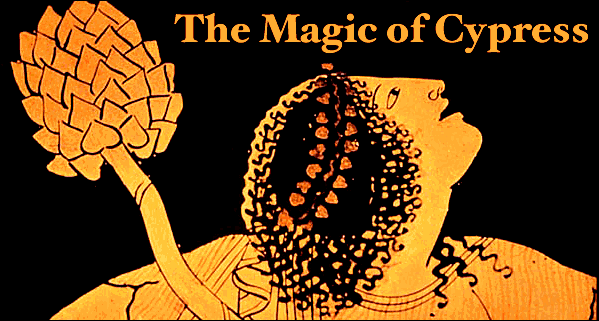 Western Civilization owes its intellectual accomplishments to the achievements of two great cultures. Egyptians are credited with the origin of language and writing, the basis of scholarship, while ancient Greeks lay claim to our understanding of nature, science and reason. But while these two great empires are often blazed in the books of human history there remains an unknown and mysterious benefactor in the form of a tree. ViewZone learned of this tree quite by accident. Our "Expedition 2001" flew from Yemen to the outback of Australia's Flinders Range to explore ancient petroglyphs in the region. It was there that we met arborist, John McGovern, who was our guide and host in the "land down under." Camping among the kangaroos and emus, ViewZone editor, Gary Vey, burned a large piece of frankincense from Yemen at a remote campsite one evening. The strong perfumed scent carried throughout the site and initiated a discussion about the origin of this fragrant resin. Frankincense was an important substance in the millennia before Christ. It was obtained by collecting the sap from a special tree that grew only in the Arabian peninsula and was the basis of wealth for the Queen of Sheba. On a hike the following morning, John noticed a chunk of yellow substance on the base of an evergreen tree found throughout the Australian continent. A quick sniff identified the chunk as the tree's resin and recalled the discussion of the previous evening. Taking a butane lighter, he heated the chunk and allowed it to smoke. The sweet perfumed scent was immediately recognized and our expedition party was soon collecting more of this resin for the next evening's camp fire. We became curious about the strong similarities to frankincense and asked John to tell us more about this unique tree. We were not prepared for his discussion. It turned out that the common evergreen, really a Cypress tree of the genus Callitrus, had played as important a role in human civilization as any famed Egyptian pharaoh or Greek philosopher. Further, as John traced the written history of this tree, we learned a lineage of greatness that, like frankincense, had its roots in Yemen. The Tree of Life
The Cypress tree was known in Ethiopia as Thyia, after the Ethiopian region of Thyia where it was cultivated in groves, and where the descendants of the Queen lived. The Queen and her offspring were generally considered to be "jinn" -- a type of magical or superhuman from whence we get the term "genie." One characteristic that identified the "jinn" was a complexion of light skin which stood in marked contrast to the dark skin of Arabic, African and Semitic people of the region. A descendent of the Queen, Lady Rodophos Nitrocris, daughter of Ethiopian King Phiy, was such a "jinn." In fact, the term "ruddy complexion" comes from Lady Rodophos first name. In earlier times, this Rodophos or "ruddy" complexion was sufficient reason to be put death by fearful rulers. Lady Rodophos would, along with the Thyia tree, become the guardian of human civilization. As John McGovern told us the story, we began to understand how fragile and incomplete our traditional history of this era was.
To perform this urgent preservation of knowledge and scholarship, King Phiy needed a capable leader who could be trusted with this important task, and he found such a leader in Lady Rodophos' brother, Taharka Aesiopis. Taharka was a black man from Ethiopia, a descendent of Noah, and more famous for his metaphorical stories (i.e. Aesop's fables) than his true contribution to Western Civilization. Lady Rodophos became Egypt's "Divine Votaris," the symbolic wife of the god Amon and the functional High Priestess of Africa, Asia and Europe. Her exact title was Thyia, "the Sacred Mother of the Thyia trees." She was also known as Athena Nikephoros, goddess of 'wisdom' and the famous "black Athena" -- goddess of wisdom and victory. Although her complexion was light, she was racially Ethiopian.
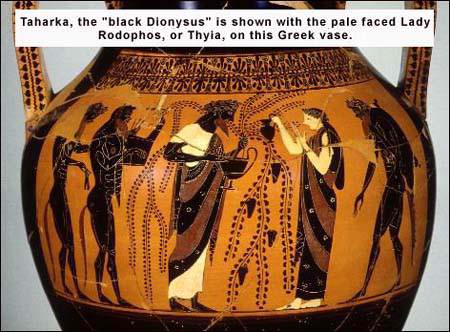 As each new center of knowledge was transplanted to safer locations, a small army of workers preceded the armada and prepared the land by planting a sacred grove of Thyia trees. So important and essential was this particular tree that an entire oracle center was once moved hundreds of kilometers because the Thyia grove was no longer viable. We know that the resin from this tree was used in the sacred fires that smoked beneath the oracle's seat, where they were usually suspended on an elevated tripod. We know that many sacred objects were constructed using the wood of this tree. But the exact significance of the tree remains elusive.
The Thyia tree was sacred to the Zoroastrians God of Light Ormazd. His worshipers had taken the tree to Armenia in prehistoric times as attested to by petroglyphs from Armenia, clearly showing the Thyia 'Tree of Life' growing out of the body of the cosmic Serpent. (This is a metaphor for it's ability to commune between Earth-cosmic Serpent and the stellar-cosmic serpent formed by the galactic arm in the southern skies, as an antenna to the gods). From Armenia, the tree was taken into western China where Thyia bestowed her manifold gifts. Thyia 'Tree of Life' and the Oracle of Delphi Taharka (Apollo/Dionysus/Aesop) and his sister Rodophos Nitocris=Athena Nikephoros/Thyia, establish the Thyia forests of Delphi, Dodonna, Thebes, Siwah, etc. The names Thyia and Rhodopis came to be confused, with historians treating them as two separate individuals; they were in fact referring to the same person. Rodophos was an appearance title, while Thyia was a functionary title. She was the High Priestess of the replenishment rituals. Her 'Thyiades' were the rest of the female virgin priesthood of Fertility and replenishment of the Sacred Thyia tree. Why was this particular tree so significant? There can be no doubt that the sacred resin of the Thyia tree called 'Thy-ion' burned in the censors of Thebes, Siwah, Dodonna and Delphi. Thy-ion was indeed the universal resin -- the HOLY SMOKE, the incense of Prophesy. Perhaps it had some hallucinatory properties. The 26th Dynasty of Egypt was eventually conquered by Ashurbanipal in the year 666 BC. The Priesthood of ON, in a diaspora out of the maws of the 666 BC Beast, carried the ripe seeds of the future Thyia forests of Delphi and Dodonna; the seed still within the unopened pods, thickly encrusted on the branches, in the form of Thyrsus', piled high in the holds of their merchant ships. All cultural explosions of this era can be attributed to this Great 'end of the old world' Exodus, from the Old World to a New World in the Northern Mediterranean, Europe and as the site of the Colorado Canaanite inscriptions tell us, the Americas, (book of Mormon: story of Nephi's escape from the Assyrian Beast in 666 B.C.). 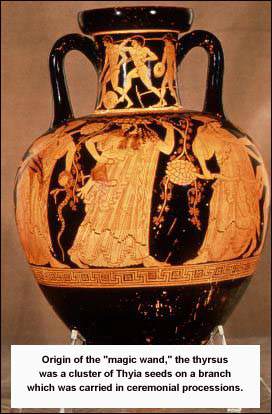 The 'Thyrsus', precursor of the fairy wand, was the fertility instrument used to propagate the forests of Thyia Trees, where the Oracles were to be established. The 'Thyiades' were the female priesthood whose responsibility it was to conduct the Replenishment Rituals of the Thyia Tree each year to ensure re vegetation. The fleets of Taharka carried tens of thousands of Thyia branches heavy with un-opened nuts/seed-pods which can grow upon one another to a depth of several layers as seen on the Thyrsus on the Greek Vase displayed.. After cutting and transportation to Delphi and Dodonna, Taharka/Dionysus and Thyia/Athena initiated the first European Thyia replenishment rituals, where the priestesses carried the branches, heavy with ripe seed around the landscape marked for re-reforestation. Over the couple of weeks it took for the rituals, the seed pods would gradually open and the seed, which have little wings, would fly through the air like fairy dust, as the Thyiades danced around in an ecstasy each with a Thyrsus. The Sexual energy of the virgin priestess was directed into her 'Thyrsus' to add the powerful human life force to the seed and awaken it from its dormancy. The Satyrs etc. were the elemental creative forces of being invoked to cue the seeds to awaken. We give credit to Taharka for having the foresight to preserve the sacred knowledge by moving the oracle sites, and to his sister for propagating the sacred groves of Thyia. These centers were vital in the development of mathematics, geometry, philosophy and democracy, as well as cosmology and religious awareness. They were, in fact, the seedlings of all that make our present civilization what it is. The fact that the Thyia tree played such a vital and central focus of these important sites will forever make this tree, of all the trees in the garden, special. Thyia 'Tree of Life'. For the healing of the Nations Thyia trees contain a marvelous medicine. Ancient peoples of Australia, Africa, and India have been using this tree from the dawn of human activity The 3,000,000 year old 'Lucy' comes from Ethiopia and would have sucked a Thyion 'cough-drop' (small ball of resin) now and again. Even three millions years ago a hominid could have benefitted from the effects of Thyion gum's anti-viral, anti-bacterial and anti-parasite properties. Indeed, all of these properties have been well established by modern scientific research and could account for the unique significance of this tree.
|
|
Ancient healing applications John McGovern told us that the Australian aboriginals hold the 14 or so native Callitris species in the highest regard and have used their medicine since the Dreamtime, (the creative beginning), i.e. for at least 60,000 years. Traditional methods of using essential oil-bearing plants include: 1). Crushing the leaves or plant parts either by hand or in a container, and inhaling the oil vapors. 2).Crushing the leaves or plant parts and applying the paste as a poultice, covered with clay or bound with bark. 3).Cutting pieces of bark from the tree and wrapping the part of the body being treated, tying the bark on with vines. 4).Throwing the bark or leaves onto heated stones or into warm ashes, and inhaling the vapors. 5).The bark is pounded, placed in water, and heated. The liquid is then spread over the body part being treated. The Tiwi islanders and some mainland aboriginal groups use Callitris intratropica in very specific ways: 1). As a wash: To relieve abdominal cramps. Also applied to sores and cuts. Occasionally used internally to treat abdominal pain and discomfort. About a handful of freshly gathered inner bark is pounded and heated in about 500 ml of water. The cooled liquid is spread over the body, and a long strand of inner bark is wrapped around the abdomen (to relieve abdominal cramps). 2).As an insect repellent: The bark is thrown into the camp fire to drive off mosquitoes and midges. 3).As an analgesic: To relieve minor aches and pains. The wood ashes are mixed with water and smeared over the affected part of the body. It is used for the treatment of stomach problems like cramps and diahorrea; viruses; sunburn damage; skin ulcers, wounds; complaints like Scoricis and drying of old skin in the elderly. The essential oil from the tree alleviates the pain and swelling of arthritis with anti-inflammatory properties; in particular the clear oil from the leaves and twigs. |
The Essential Oil today
The Golden THY-ION resin, sacred to Apollo and the Muses, is still the source of the finest natural wood varnish known to mankind being used even today to protect fine musical instruments, and the secret of the 'Stradivarius'; the beat goes on endlessly through ten's of million of violins, violas, chelos, bases, harpsichords grand pianos and mighty church organs. Every symphony played every where and anytime in the world from the past are sounded through THY-ION, Apollo's (musicians') fine wood varnish. (Thy-ion sets the 'Light Tone'). Will the future hold even more uses for this remarkable tree? It is speculated that this wood, because of its aromatic fragrance, could become a viable substitute for scarce sandalwood, in great demand for Hindu funeral rituals, as well as an important additive in sun screen lotions. John McGovern is currently examining the tree for its pharmaceutical potential. Only time will tell. But the Cypress tree stands as one of the most important plants in human history. |
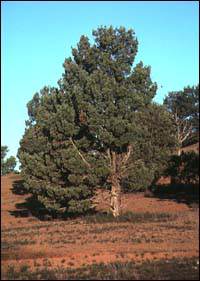 The Bible tells us that God instructed Noah to build his ark from "gofer wood" -- another name for the Cypress tree. (Revelations 1:11 and 2:18) Noah is a good starting point for our story because it is Noah's son, Shem, whose descendants gave way to the Queen of Sheba and the founding of Yemen's capitol, Sana'a. The Queen's empire was wealthy and firmly established in the South Arabian peninsula until she unexpectedly moved her kingdom across the Red Sea to Ethiopia.
The Bible tells us that God instructed Noah to build his ark from "gofer wood" -- another name for the Cypress tree. (Revelations 1:11 and 2:18) Noah is a good starting point for our story because it is Noah's son, Shem, whose descendants gave way to the Queen of Sheba and the founding of Yemen's capitol, Sana'a. The Queen's empire was wealthy and firmly established in the South Arabian peninsula until she unexpectedly moved her kingdom across the Red Sea to Ethiopia. 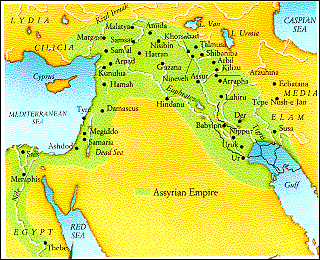 In the seventh century before Christ, the Assyrians under King Ashurbanipal, were marching West towards Egypt, laying waste to the nations that were in their path. Prior to his arrival in Egypt, that empire had joined with Ethiopia to form a stronghold against the invading Assyrians. The 26th dynasty of Egypt, also called the "Ethiopian dynasty" was ruled by Ethiopian King Phiy. Realizing the dangers that were ahead, Lady Rodophos formed a brotherhood of Kings, called Adelphos, and sought to move the cultural centers from Africa and Asia to new and more secure locations in South Europe. Her plan would establish libraries, schools and oracle sanctuaries that would insure against the demolition of the Assyrians.
In the seventh century before Christ, the Assyrians under King Ashurbanipal, were marching West towards Egypt, laying waste to the nations that were in their path. Prior to his arrival in Egypt, that empire had joined with Ethiopia to form a stronghold against the invading Assyrians. The 26th dynasty of Egypt, also called the "Ethiopian dynasty" was ruled by Ethiopian King Phiy. Realizing the dangers that were ahead, Lady Rodophos formed a brotherhood of Kings, called Adelphos, and sought to move the cultural centers from Africa and Asia to new and more secure locations in South Europe. Her plan would establish libraries, schools and oracle sanctuaries that would insure against the demolition of the Assyrians. 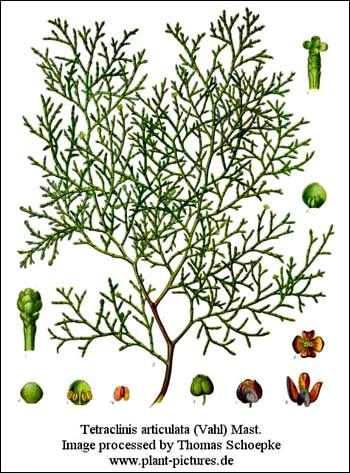 The Thyia (Callitrus) tree is a Gondwana Flora and therefore native to the Southern hemisphere; e.g. Australia, Africa, India and South America. The Thyia trees was also taken to Malta and Morocco where it is known by it's Phoenician name, the Arar tree. The name means leathery skin, referring to the it's amazing ability to heal flesh wounds and Thyion resin varnish's tough protective skin. Thyia was transplanted to Greece by Taharka/Aesop and Nitocris/Thyia and their 'Boat People'.
The Thyia (Callitrus) tree is a Gondwana Flora and therefore native to the Southern hemisphere; e.g. Australia, Africa, India and South America. The Thyia trees was also taken to Malta and Morocco where it is known by it's Phoenician name, the Arar tree. The name means leathery skin, referring to the it's amazing ability to heal flesh wounds and Thyion resin varnish's tough protective skin. Thyia was transplanted to Greece by Taharka/Aesop and Nitocris/Thyia and their 'Boat People'. 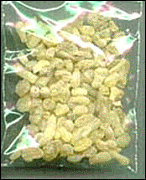 The essential oil from the heartwood is Cobalt Blue, very rare and special, having only been successfully extracted as recently as 1996. The Blue cypress oil is one of the world newest essential oils and in very limited supply from a few Australian aboriginal plantations. It is the essential oil for the third Millennium with many as yet undiscovered properties. Blue Cypress Oil is unique in the essential oils world, since it is the only essential oil from wood containing 'guaiazulene', with many pharmaceutical applications. It is also the only blue oil with a woody, smoky fragrance. All other natural blue oils are derived from flowers (such as chamomile, matricaria, artemisia and tansy) and so lack the fragrance of Blue Cypress Oil. The oil also contains selinenes, eudesmols, and other compounds with significant fragrance properties. Aesthetically important is its striking blue color, which has positive connotations in all culture. It is an interesting fact that all existing blue oils have anti-inflammatory properties. While Blue Cypress and Chamomile oils have similar low volatility profiles, Blue Cypress Oil is one-third the price of Chamomile Oil, and is more color-stable. There are good marketing opportunities for Blue Cypress Oil as a viable alternative in many cosmetic and toiletry applications, and as a future therapeutic alternative.
The essential oil from the heartwood is Cobalt Blue, very rare and special, having only been successfully extracted as recently as 1996. The Blue cypress oil is one of the world newest essential oils and in very limited supply from a few Australian aboriginal plantations. It is the essential oil for the third Millennium with many as yet undiscovered properties. Blue Cypress Oil is unique in the essential oils world, since it is the only essential oil from wood containing 'guaiazulene', with many pharmaceutical applications. It is also the only blue oil with a woody, smoky fragrance. All other natural blue oils are derived from flowers (such as chamomile, matricaria, artemisia and tansy) and so lack the fragrance of Blue Cypress Oil. The oil also contains selinenes, eudesmols, and other compounds with significant fragrance properties. Aesthetically important is its striking blue color, which has positive connotations in all culture. It is an interesting fact that all existing blue oils have anti-inflammatory properties. While Blue Cypress and Chamomile oils have similar low volatility profiles, Blue Cypress Oil is one-third the price of Chamomile Oil, and is more color-stable. There are good marketing opportunities for Blue Cypress Oil as a viable alternative in many cosmetic and toiletry applications, and as a future therapeutic alternative. 